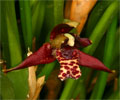|
|
|
|
|
| |
Flasks of
Maxillaria tenuifolia 'Flagrant' × 'Bain de Soleil' |
|
| |
|
|
| |
| Number: |
TN6742 |
| Name: |
Maxillaria tenuifolia 'Flagrant' × 'Bain de Soleil'
|
| Type: |
outcross (What's that?) |
|
Seed Donor: |
Troy C. Meyers
|
|
Click to Enlarge

Pod Parent Flower |
Click to Enlarge

Pod Parent Blooming Plant |
Click to Enlarge

Pollen Parent Flower |
|
|
|
| |
Culture Notes from Donor: Parent plants: Temperature range I (60-83°F)
Comments: Pod parent plant: A highly colored cultivar with flowers held prominently on longer than normal pedicels.
Pollen parent plant: Dark flowers, strong coconut scent. Medium-sized plant.
For additional origin/habitat information supplied courtesy of
Charles and Margaret Baker, see further below, near the bottom of this page.
|
Temperatures we attempt to use in the lab & greenhouse:
| For Species: |
|
Spring, Summer, Autumn: days average 83°F, nights 67°F; best fit is Warm-Intermediate 87-64°F
(Source:
Baker's Web OSC) |
| For Species: |
|
Winter: days average 74°F, nights 58°F; best fit is Cool-Intermediate 75-58°F
(Source:
Baker's Web OSC) |
|
About the name...
| Etymology of |
Maxillaria |
|
From Latin "maxilla" jawbone.
(Source:
Pridgeon 1992) |
| Etymology of |
tenuifolia |
|
From Latin "tenuis" thin; "folium" leaf.
(Source:
Brown 1956) |
| Pronunciation of |
Maxillaria |
|
max-ill-AIR-ee-a
(Source:
Pridgeon 1992) |
| Pronunciation of |
tenuifolia |
|
ten-yoo-i-FOE-lee-ah
(Source:
Hawkes 1978) |
|
If you would like to direct someone to this web page, please copy and paste this URL into your email:
http://troymeyers.com/d?016742
| Flask Information |
| Availability: |
We have sold all of the flasks for this item. |
| You should: |
Consider getting individual plants or compots instead of a flask.
See if we have plants available in the greenhouse. |
| Yield Estimate: |
124 plants (based on flask surveys done 10/29/2009 through 11/11/2009)
|
| Plantlet Sizes: |
From many flasks 55 - 100 mm plants (based on flask surveys done 07/12/2010 through 08/09/2010)
From one most recently surveyed flask 55 - 100 mm (08/09/2010)
|
|
You might also want to:
|
View the seed assay for this item.
See if we have plants available in the greenhouse.
View items of the same species.
View items of the same genus.
|
| Ordering Information |
| You are not currently logged in. |
|
You must be a registered user and be logged in to reserve a flask or place a notification request. Please log in:
|
|
|
|
|
|
| |
The origin/habitat information below is supplied courtesy of Charles and Margaret Baker
The following information is based on the name of the plant provided by the donor, and assumes that the name is correct. If the plant has been misidentified, then the following information may not be correct.
This text is copyrighted by the Bakers and may not be reproduced without permission.
ORIGIN/HABITAT: Mexico, Gratemala, Belize, El Salvador, and Nicaragua. In
the past, it has also been reported as occurring in Costa Rica, but recent
work indicates its occurrence there is doubtful. Plants grow in
rainforests, tropical semi-deciduous forests, and sometimes in ravines in
warm oak forest. They are found a lower elevations from near sea level to
about 3300 ft. (1000 m).
More about this information and the Bakers...
|
|
|
| |
|
|
|